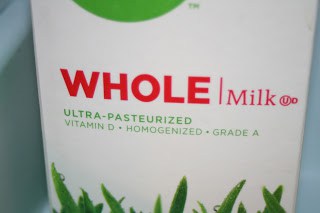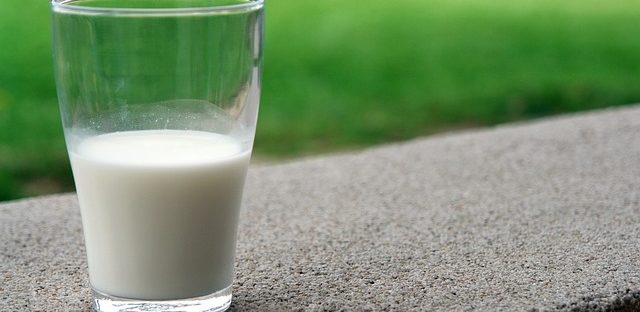We’ve all been told to drink our milk, but is it advice we should follow? The truth is that milk is not healthy for us for a number of reasons. We are the only mammals on the planet to drink another animal’s milk. After we are weaned from our own mother’s breast milk, most humans no longer produce the enzyme lactase needed to digest lactose in milk, which is why so many of us get stomach aches from too much dairy. Commercial milk which is pasteurized and homogenized is highly allergenic as well as inflammatory.
According to Frank Oski, MD, Physician-in-chief in Johns Hopkins Children’s Center, “commercial milk is responsible for most of the gastrointestinal problems in infants and children and causes, among others, chronic low-level intestinal bleeding, leaky gut, tooth decay and tension fatigue syndrome, while increasing the risk for developing diseases such as multiple sclerosis.”[V]
Sign of milk sensitivity are:
- diarrhea
- gas
- bloating/swelling in the abdomen
- abdominal pain/cramping
- nausea, vomiting
- headaches or migraines
- acne
- seasonal allergies
- breathing problems
- skin rash, eczema
Pasteurization
It is required by law in most states that all milk sold to consumers must be pasteurized. The process of pasteurization heats up the milk, killing any possible harmful bacteria, but in turns kills all of the healthy bacteria as well as vitamins and minerals. You may now have noticed many dairy products labeled “ultra-pasteurized,” especially in organic milk. This milk has been heated to a very high temperature in order to extend the shelf life of the milk. Unfortunately, this milk is very difficult to digest and can lead to all sorts of health problems.

Homogenization
The homogenization process became a practice in the milk industry because it extends the shelf-life of the milk. However, this process breaks down the fat molecules in milk and changes the proteins and fat. Thus instead of slowly absorbing the nutrients in milk, it quickly goes into our system, causing inflammation.
What about Calcium?
It is also a myth that we can obtain calcium from drinking milk. The problem is that pasteurized milk is very acidic. So to maintain a Ph that is alkaline, our bodies will pull the calcium out of our bones to keep that balance. This explains why the populations in the world that are the highest consumers of dairy have the highest rates of osteoporosis and bone fractures. What’s even more disturbing is that studies have found that consumers of commercial milk also have higher mortality rates, particularly in women. [IV]
Antibiotics and rBHG
One glass of milk contains the residue of over 100 antibiotics. Because most of our milk comes from sick cows in confined animal feed lots, antibiotics are used to treat the animals. It is the use of these antibiotics in the food we are consuming that is leading to “super bugs” which are bacterial infections that have become resistant to antibiotic treatment.
A genetically engineered artificial hormone known as rBHG is injected into cows to make them unnaturally produce more milk. This hormone has been linked to several cancers.[I]
Is organic better?
While organic is better in the sense that these cows are fed organic food, this milk still comes from cows in feed lots who are eating grains, and their milk is still pasteurized and homogenized, therefore killing all of the beneficial enzymes needed to digest the milk.
Low fat
In no way should any human ever consume any dairy product labeled low fat, or non-fat. In fact, no one should consume any food labeled low-fat. Consumers must realize that when you take the fat out of dairy, which is the main component, you must replace it with something. That thing is almost always sugar. On top of that, the process of defatting dairy products, so denatures the food, that it will do more harm to your body than help. You will often find people who consume diets of low-fat foods are overweight because fat does not make you fat. Sugar makes you fat.
Raw Milk?

Raw milk is milk that has not been pasteurized or homogenized. 100% grass-fed raw milk has been shown to have some medicinal properties. A-2 raw milk is easier to digest and can be beneficial for some health conditions. It can be purchased directly from farmers in some states.
Fermented dairy
There are some forms of dairy that can be beneficial to humans, and those are fermented foods. These include kefir, plain yogurt, sour cream, and aged cheese. These foods should still be made from raw milk as the pasteurization process again kills the beneficial bacteria in the milk. All flavored yogurt contains high amounts of sugar and is not a health food.
milk substitutes
There are so many milk substitutes out there that work great in baking and taste great. Almond milk is one of the best. Click here to learn how to make it yourself!
[I]Epstein, S. S. “Unlabeled Milk from Cows Treated with Biosynthetic Growth Hormones: A Case of Regulatory Abdication.” International Journal of Health Services: Planning, Administration, Evaluation. U.S. National Library of Medicine, 1996. Web. 31 May 2017.
[II]International Dairy Foods Association. 2013. Milk Pasteurization: Definition and Methods. http://www.idfa.org/news–views/media-kits/milk/pasteurization-/
[III]Laugesen, M., and R. Elliott. “Ischaemic Heart Disease, Type 1 Diabetes, and Cow Milk A1 Beta-casein.” The New Zealand Medical Journal. U.S. National Library of Medicine, 24 Jan. 2003. Web. 31 May 2017.
[IV]Michaëlsson K, Wolk A, Langenskiöld S, Basu S, Warensjö Lemming E, Melhus H, Byberg L. “Milk intake and risk of mortality and fractures in women and men: cohort studies.” BMJ. 2014 Oct 28;349:g6015. doi: 10.1136/bmj.g6015.
[V]Roumeliotou, Eleni. “In Defense of (Raw) Milk.” GreenMedInfo. N.p., 02 July 2015. Web. 31 May 2017.
[VI]Virtanen, S. M., T. Saukkonen, E. Savilahti, K. Ylönen, L. Räsänen, A. Aro, M. Knip, J. Tuomilehto, and H. K. Akerblom. “Diet, Cow’s Milk Protein Antibodies and the Risk of IDDM in Finnish Children. Childhood Diabetes in Finland Study Group.” Diabetologia.U.S. National Library of Medicine, Apr. 1994. Web. 31 May 2017.
Latest posts by Erin Sands (see all)
- Meyer Lemon Tart – Gluten/Dairy Free - January 23, 2020
- Gingery Roasted Cranberry Sauce - November 9, 2019
- Blueberry Skillet Baked Oatmeal - June 18, 2019

The calcium issue continues to amaze me. Great article!
Great article! I am one of the many people that thinks milk is healthy for us, cause that’s what I learned growing up. I will have to show my wife this article because she too thinks milk is healthy. Thanks for the info. I am glad you wrote this article so I can learn the truth about milk.
We all grew up on that! I used to drink a gallon a week alone. Most people believe it is the best source of calcium. The problem is that milk is so acidic, our bodies actually need to pull the calcium out of our bones to alkalize the body. That explains the high rates of osteoporosis in milk drinking populations.
Very informative. Unfortunately milk does not agree with my system. I have always though that like other animals we are suppose to get the milk from our mothers for a period of time and then thats the end of it. I have found coconut milk to be very enjoyable. When I clicked on the link to how to make milk I see you only have almond. Will you add coconut to that list?
Hi Max! You’re right. We are the only animals in the world that drink another animal’s milk. Good idea about the coconut milk, I’ll add oat milk too. All I do is pour boiling water over a cup of coconut flakes. Then add 3 more cups of cool water. Process it in the blender and pour through my nutbag or cheesecloth.
Thanks for such a comprehensive article on something I’ve been telling everyone I know for years. We’ve been “fed” a lot of misinformation on dairy in the name of profits, and I always applaud those who help bring the truth into the light. Bravo!
Amen, Erin. I think you summed the pointlessness of cow’s milk beautifully. And you know what, people will still not believe you (or me), because of the sheer pressure of the dairy lobbies out there and the heavy marketing in the shops. But the more articles like yours are written and shared, the more people out there will see the light. Thanks for this, keep up the good work. 🙂
I agree. Just look in the grocery store. Just about everything has cheese in it. We are eating more dairy than ever. The government got involved 30 when they first urged Americans to start eating low fat. This left a huge surplus of milk fat that they started buying up to help dairy farmers. They had warehouses full of it.They couldn’t sell enough of it to other countries, so they embarked on an advertising campaign to get people to eat more cheese. Well, it worked. Education will hopefully turn people back.